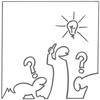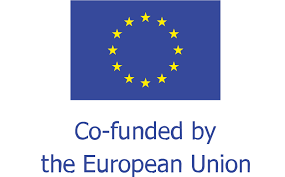Instructions
This exercise will focus on both your problem solving and teamwork skills. Nonverbal communication is important to solve the puzzle. You will start this exercise with little information in advance.
Step 1
To prepare: You need one complete set of the puzzle for each group. Cut out the puzzle pieces and write the letters according to the key, on each piece. Make sure you write the letters with a pencil, that way you will be able to erase them later.
Erase the letter you wrote on the pieces after you cut them out and replace them with the letter of the envelope they belong to. This will make it easier for you to collect them and reuse.
Mark the envelopes with the letters A, B, C, D, E
- In envelope A, put pieces: I, H and E
- In envelope B, put pieces: A, A, A and C
- In envelope C, put pieces: A and J
- In envelope D, put pieces: D and F
- In envelope E, put pieces: G, B, F and C
You will later hand out one envelope each to every group member. Explain that the letter on the envelope has nothing to do with solving the puzzle.
Step 2
Split into groups of five. If any group has more than five people, the extra participant can be active as an observer. Tell the participants that the exercise is to practice problem solving and teamwork.
Step 3
Give every group a separate space or table.
Step 4
Give each member of the group an envelope. Make sure that they do not open them until they have had the following instructions.
- Every group is supposed to put together five equally large squares from the pieces in the envelopes.
- You are not allowed to talk to each other.
- You are not allowed to take puzzle pieces from another participant if they are not handed to you.
Observers: Each observer gets a piece of paper and will take notes during the process. After the exercise is finished the observer will share their observations with the group.
Check list for the observer (can also be you):
- Does everybody follow the rules?
- Is anyone passive?
- In anyone acting as the leader of the group?
- Has anyone seen the solution but has not been able to communicate it to the group?
- Do the participants start taking the pieces from each other after a while, instead of waiting for someone to hand the piece to them?
- Other observations.
Step 5
After the exercise is finished the participants often have a pent up need to communicate verbally with each other.
Feedback – Discuss the exercise based on the notes made by the observer or yourself:
- What made you choose to break or follow the rules?
- What made you choose to be active or passive during the exercise?
- Did anyone take the leader role? What made that come about?
- Did anyone see the solution but chose to not communicate it to the rest of the group? How did that come about? What could you have done differently?
- Did the participants start taking pieces from each other after a while, instead of waiting for others to hand them to them?
- What made this happen? What did it mean to the group process?
Collecting and sharing student results
There will be a group discussion after the exercise. The instructor can also take notes which can be used during individual evaluation talks with the participants at a later date.
Reflection/self-assessment
- Did it go as planned?
- Was the exercise valuable in working with the specific soft skill?
- Did the participants understand the task?
- Does something need to be changed/explained until next time?
The exercise is a good starting point to start to talk about the group process and to understand their own part in a group process. It can help them to understand which role they usually take. If they want a change in their approach it is important to understand their own starting point.
Instructions
This exercise will focus on both your problem solving and teamwork skills. Nonverbal communication is important to solve the puzzle. You will start this exercise with little information in advance.
Step 1
To prepare: You need one complete set of the puzzle for each group. Cut out the puzzle pieces and write the letters according to the key, on each piece. Make sure you write the letters with a pencil, that way you will be able to erase them later.
Erase the letter you wrote on the pieces after you cut them out and replace them with the letter of the envelope they belong to. This will make it easier for you to collect them and reuse.
Mark the envelopes with the letters A, B, C, D, E
- In envelope A, put pieces: I, H and E
- In envelope B, put pieces: A, A, A and C
- In envelope C, put pieces: A and J
- In envelope D, put pieces: D and F
- In envelope E, put pieces: G, B, F and C
You will later hand out one envelope each to every group member. Explain that the letter on the envelope has nothing to do with solving the puzzle.
Step 2
Split into groups of five. If any group has more than five people, the extra participant can be active as an observer. Tell the participants that the exercise is to practice problem solving and teamwork.
Step 3
Give every group a separate space or table.
Step 4
Give each member of the group an envelope. Make sure that they do not open them until they have had the following instructions.
- Every group is supposed to put together five equally large squares from the pieces in the envelopes.
- You are not allowed to talk to each other.
- You are not allowed to take puzzle pieces from another participant if they are not handed to you.
Observers: Each observer gets a piece of paper and will take notes during the process. After the exercise is finished the observer will share their observations with the group.
Check list for the observer (can also be you):
- Does everybody follow the rules?
- Is anyone passive?
- In anyone acting as the leader of the group?
- Has anyone seen the solution but has not been able to communicate it to the group?
- Do the participants start taking the pieces from each other after a while, instead of waiting for someone to hand the piece to them?
- Other observations.
Step 5
After the exercise is finished the participants often have a pent up need to communicate verbally with each other.
Feedback – Discuss the exercise based on the notes made by the observer or yourself:
- What made you choose to break or follow the rules?
- What made you choose to be active or passive during the exercise?
- Did anyone take the leader role? What made that come about?
- Did anyone see the solution but chose to not communicate it to the rest of the group? How did that come about? What could you have done differently?
- Did the participants start taking pieces from each other after a while, instead of waiting for others to hand them to them?
- What made this happen? What did it mean to the group process?
Collecting and sharing student results
There will be a group discussion after the exercise. The instructor can also take notes which can be used during individual evaluation talks with the participants at a later date.
Reflection/self-assessment
- Did it go as planned?
- Was the exercise valuable in working with the specific soft skill?
- Did the participants understand the task?
- Does something need to be changed/explained until next time?
The exercise is a good starting point to start to talk about the group process and to understand their own part in a group process. It can help them to understand which role they usually take. If they want a change in their approach it is important to understand their own starting point.
Assessment Methods
- Discussion
Resources needed (per group)
- 1 printed set of puzzles
- 5 envelopes


 30 Minutes
30 Minutes










